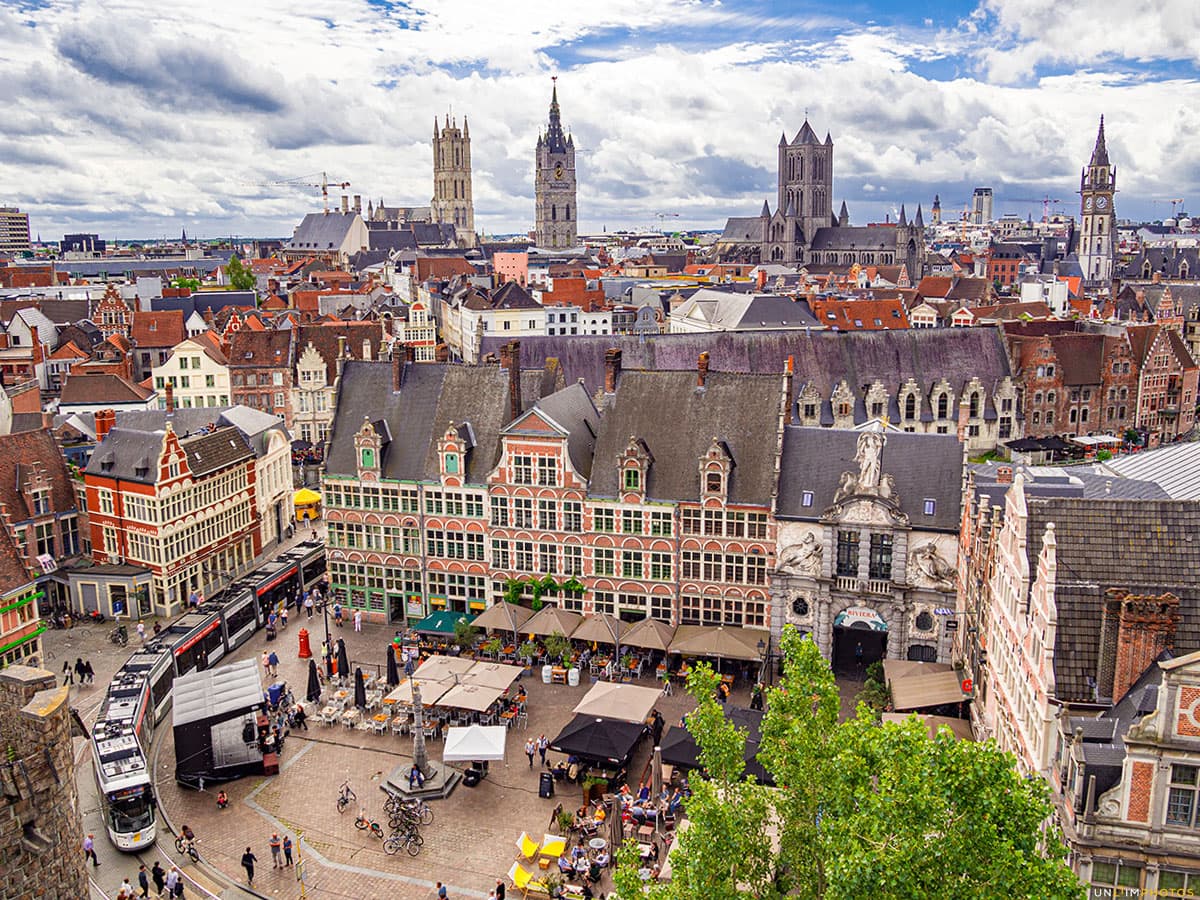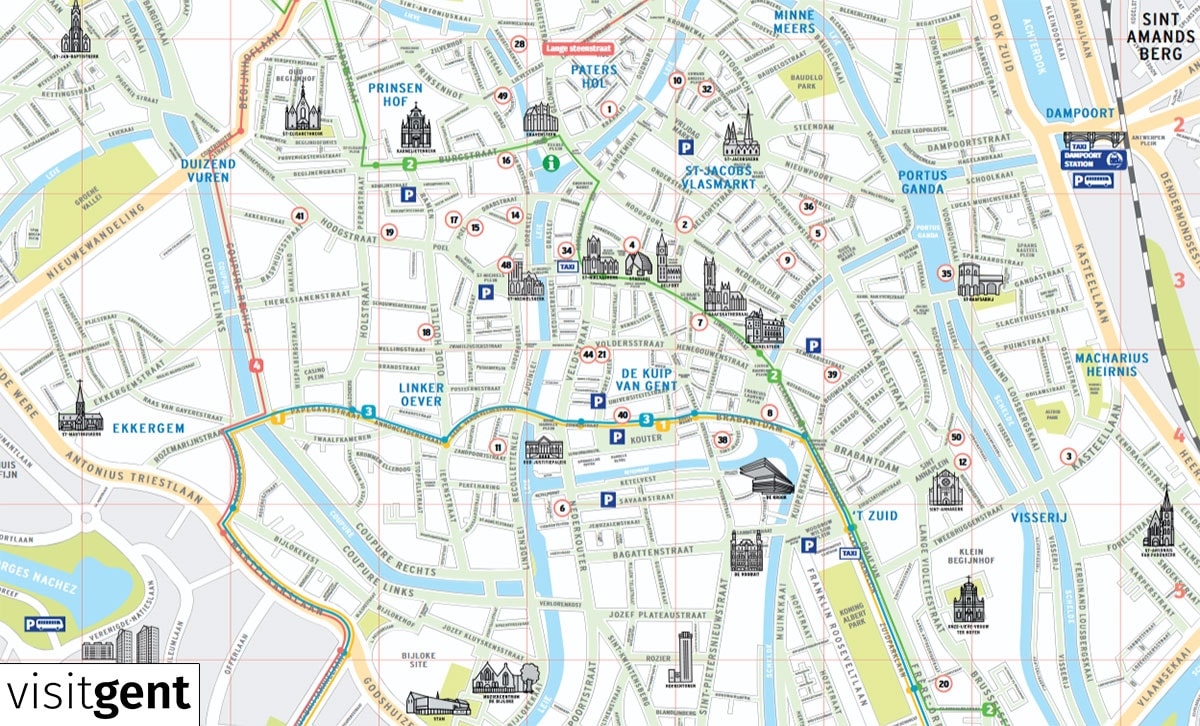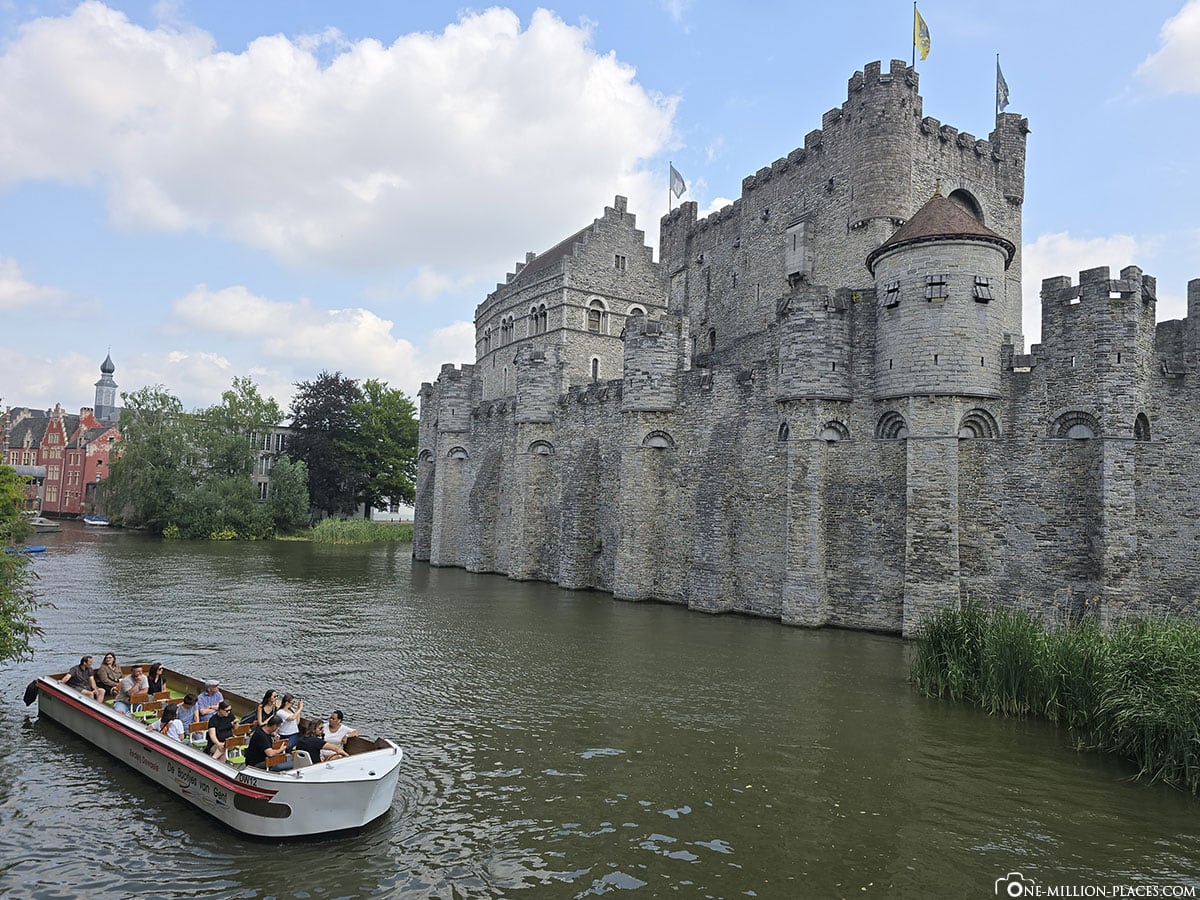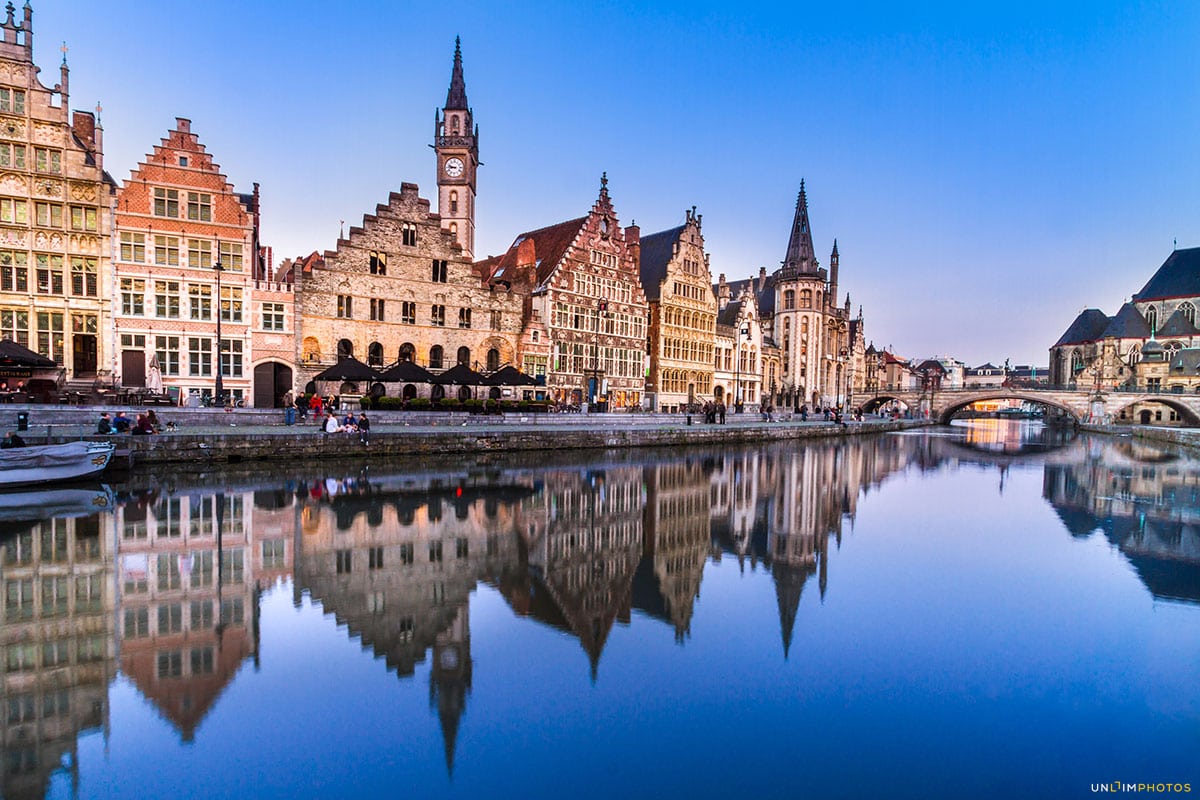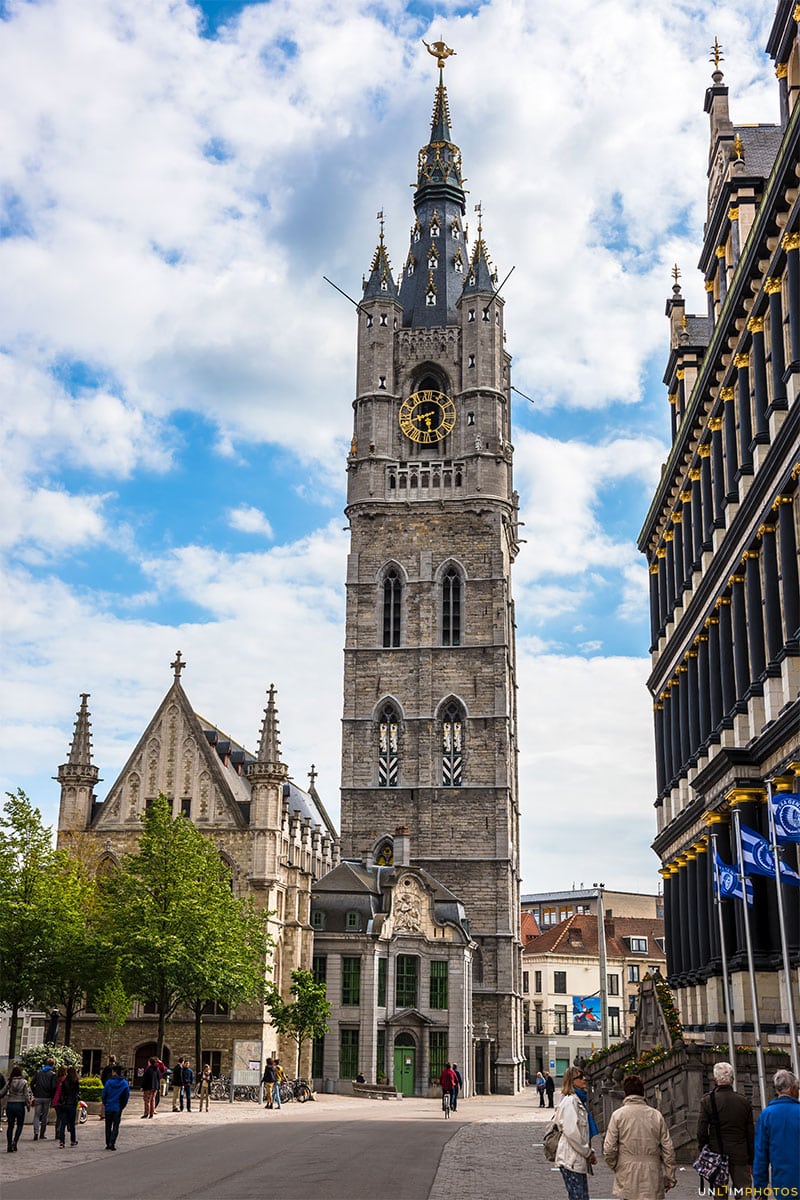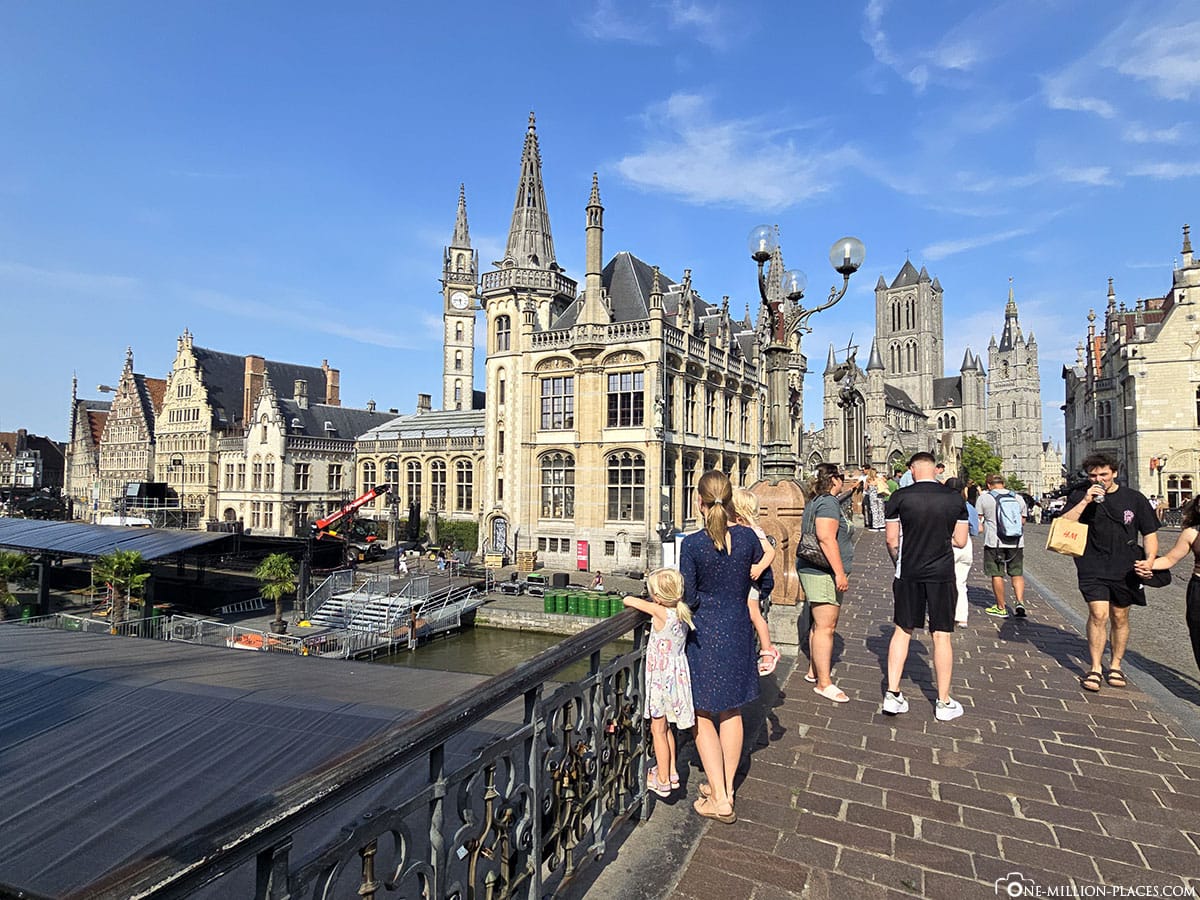We visited Ghent on a summer’s day in July and explored the city on foot and on our own with our two kids. In our travel report, we share our experiences and show you the most important sights and photo spots such as the Castle Gravensteen, the Graslei riverside promenade, St. Bavo’s Cathedral and the UNESCO World Heritage Belfry of Ghent.

Table of contents
Things to know about the city of Ghent in Belgium
Ghent is located in the north-west of Belgium in the Flanders region and is the third largest city in the country after Brussels and Antwerp with around 265,000 inhabitants. The city is located at the confluence of the rivers Leie and Scheldt and was one of the most important trading centers in Europe in the Middle Ages. Especially in the 13. and In the 14th century, Ghent experienced an economic boom thanks to the cloth industry. Today, Ghent is a vibrant university city with a rich history, well-preserved architecture and a strong focus on sustainability and culture.
A particular highlight of Ghent is the impressive cityscape with its numerous historic buildings. The city’s UNESCO World Heritage Sites include the medieval Belfry of Ghent (part of the World Heritage Site “Belfriede in Belgium and France”) and the Great Beguinage O.L.V. Ter Hoyen, which is part of the World Heritage Site “Flemish Beguinages”. Both buildings are emblematic of the social and urban history of Flanders. Other architectural highlights include St. Bavo’s Cathedral, which houses the famous Ghent Altarpiece by van Eyck, and the Church of St. Nicholas. Also worth seeing are the imposing Gravensteen Castle, the picturesque riverside promenades on Graslei and Korenlei and the Museum of Contemporary Art (S.M.A.K.).
Map of the old town
On the pages of Visit Ghent you will find many clear city maps for free download.
Sights & photo spots in Ghent
Unfortunately, during our visit to the old town, everything was already being set up for the “Gentse Feesten”, one of the largest folk festivals in Europe, which takes place for ten days every year in July. As a result, many well-known sights or views were covered by stages, which was of course a bit of a shame. Nevertheless, we set off to discover Ghent 🙂
Our first port of call was the Tourist Information Center of Visit Ghent, which is located directly opposite the Castle Gravensteen. Here we have equipped ourselves with various information brochures.
Gravensteen – A moated castle in the middle of the old town
The Gravensteen is one of the most impressive medieval buildings in Belgium and the only fully preserved moated castle in Flanders. Built in the 12th century under Count Philip of Alsace, it served as the seat of the Counts of Flanders. Its location is particularly remarkable: in the middle of the vibrant old town, the Gravensteen rises up with its thick stone walls, battlements and towers – surrounded by moats and historic facades – like a stone monument from another time.
This is exactly what makes the Gravensteen one of the most popular photo motifs in the city.
Over the centuries, the castle was used for a variety of purposes: as a court, prison and mint. Today it houses a museum that offers a fascinating insight into life in the Middle Ages with rooms furnished true to the original. Inside you can visit the knights’ hall, the torture chamber, old armor and weapons. A stone spiral staircase leads up to the castle walls – from there you can enjoy a fantastic panoramic view over the roofs of Ghent’s old town.
The Gravensteen is open daily from 10 am to 6 pm and admission for adults is EUR 12. Children and young people up to the age of 18 are free of charge. Particularly popular is the entertaining audio guide, which conveys the history of the castle with humor at several stations.
Oudburg & Kraanlei – One of the most beautiful riverside streets in Ghent
From Gravensteen Castle, we continued our walk across the Lievebrug to the Patershol district, one of the oldest districts in Ghent with narrow cobbled streets, winding rows of houses and well-preserved buildings dating back to the Middle Ages. 17. and 18th century.
The Oudburg is one of the oldest streets in Ghent and is located in the heart of the historic center. Once an important connecting axis within the medieval city, today it is known for its multicultural atmosphere, culinary diversity and lively scene. There are numerous restaurants, bakeries and tea rooms along the street offering oriental specialties – from fresh flatbread to mezze and sweet pastries. There are also many bars, small stores and art galleries here.
The Kraanlei is one of the most beautiful riverside streets in Ghent and runs picturesquely along the Leie. The name “Kraanlei” comes from an old wooden crane that was once used here for loading and unloading ships and gave the quay its name. Today, the Kraanlei is characterized by well-preserved gabled houses, small stores, cafés and museums. Particularly striking is the House of Alijn (Huis van Alijn), a folklore museum in a former beguinage that illustrates everyday life in times gone by.
Vrijdagmarkt – One of the oldest squares in the city
The Vrijdagmarkt (Friday market) is one of the oldest squares in Ghent – regular markets have been held here since the 12th century. It still bears its name today, as a traditional weekly market is held here every Friday morning. But the square is much more than just a market place: for centuries, it was the center of public life, the scene of speeches and festivals – but also of political gatherings and public executions.
Today, the Vrijdagmarkt is a popular meeting place with plenty of atmosphere: surrounded by impressive historical architecture, including the Bond Moyson trade union building with its striking façade, cozy cafés, bars and restaurants line the square. In the center is the monument to Jacob van Artevelde, a famous 14th century Ghent politician and merchant.
Korenlei & Graslei – The most famous photo spot in Ghent
The Graslei and Korenlei are undoubtedly the Instagram and photo spots in Ghent – and also the historic heart of the city. The two riverside streets run parallel along the Leie and offer a wonderful backdrop of medieval guild houses, historic warehouses and Gothic architecture. Here, the elaborately decorated facades are reflected in the water, boats glide past and the cityscape looks like something out of a picture book – especially at sunset or in the evening when the buildings are atmospherically illuminated.
Originally, the Graslei and Korenlei were important trading places in medieval Ghent, where grain and other goods were transhipped – hence the names: “Gras” and “Koren” stand for “grass” and “grain”. Whether for a walk, a boat trip or the perfect Instagram photo – if you visit Ghent, you can’t miss this place 😉
The oldest building on Graslei is the so-called Korenstapelhuis (grain stacking house), also known as the house of the grain stackers, with the house number Graslei 1. It was originally built around the year 1200 and is considered one of the oldest surviving guild houses in the city. The Korenstapelhuis served as a storage and administration building for the grain stackers’ guild, which had a monopoly on the storage and handling of grain on the Leie – an important economic sector in medieval Ghent. The Gildenhuis van de Vrije Schippers (Guild House of the Free Boatmen) was built in the 16th century and served as a guild house for the “free boatmen”, i.e. those boatmen who transported goods on the waterways and were not bound to a particular trading company.
St. Nicholas Church – part of the “three towers of Ghent”
St. Nicholas Church (Sint-Niklaaskerk) is one of the most important and oldest churches in Ghent and is an outstanding example of the Scheldt Gothic style, a regional form of Gothic architecture in Flanders. It was built in the 13th century and is dedicated to St. Nicholas, the patron saint of merchants and sailors – a fitting location for the city’s former trading center, near the Graslei. The church is characterized by its massive central tower, which once also served as a lookout point and is a striking part of the so-called “three towers of Ghent” – together with the Belfry and St. Bavo’s Cathedral. St. Nicholas Church impresses on the outside with its robust, dark natural stone façade and on the inside with its high vaults, intricate windows and impressive organ. Following extensive restoration work, the church is now open to the public again. Admission is free.
Belfry – landmark of the city & UNESCO World Heritage Site
The Belfry of Ghent (Belfort van Gent) is a landmark of the city and part of the famous “three towers” that characterize the Ghent skyline – together with St. Bavo’s Cathedral and the Church of St. Nicholas. At around 91 meters high, it is the highest belfry in Belgium and was built in the 14th century as a symbol of the city’s freedom and independence. Back then, important documents such as the town charter were kept in the tower – well protected from fire and attacks.
In addition to its political function, the Belfry also served as a watchtower from which the townspeople were warned of dangers such as fires or attacks – with bells, including the famous “Klokke Roeland”. Today, the tower houses a small museum on the history of carillons, and visitors can climb to the upper floors or take the elevator. From the top, there is a spectacular 360° view over Ghent – an absolute highlight in good weather.
The Ghent Belfry has been a UNESCO World Heritage Site “Belfry in Belgium and France” since 1999 , a recognition of its historical and architectural significance. The mixture of medieval symbolism and functional purpose-built construction is particularly impressive – a piece of living city history that has been impressively preserved to this day.
Anyone visiting Ghent should not only see this tower from the outside, but also explore the inside and enjoy the view from the top – it’s worth it! The Belfry is open daily from 10:00 to 18:00, the last admission is at 17:30. Admission costs EUR 10 for adults, children and young people under the age of 18 are admitted free of charge. If you have a Ghent CityCard, you can visit the tower free of charge.
Sint-Michielsbrug – one of the most beautiful viewpoints in Ghent
The Sint-Michielsbrug (St. Michael’s Bridge) is one of the most beautiful viewpoints in Ghent – and an absolute must for anyone exploring the city with a camera. The stone arch bridge connects the Korenlei with St. Michielsstraat and spans the Leie with a wide, elegant arch. From here, you can enjoy a unique view of Ghent’s famous three towers – St. Nicholas Church, the Belfry and St. Bavo’s Cathedral.
Originally there was a flat swing bridge on this site, but the current stone structure dates from the early 20th century and was built in the neo-Gothic style.
St. Bavo’s Cathedral & Ghent Altarpiece – one of the most important works of art in Europe
Construction of St. Bavo’s Cathedral (Sint-Baafskathedraal) began in the 13th century and was completed over several centuries until the 16th century. It combines various architectural styles, particularly Gothic and Romanesque, to create an impressive overall work. With its magnificent façade and imposing interior, it is one of the most important churches in Belgium and is the spiritual heart of Ghent. The cathedral is open daily from 9.30 am to 5.00 pm, and admission to the Ghent Altarpiece is possible from 9.30 am to 4.30 pm. Admission to the church is free, but there is a charge of EUR 12.50 for adults to visit the Ghent Altarpiece.
The absolute highlight of the cathedral is the famous Ghent Altarpiece (“Adoration of the Lamb of God”), a unique winged altarpiece by the brothers Hubert and Jan van Eyck from the early 15th century. The altar is located at the back of the church and is one of the most important works of art in Europe. The Ghent Altarpiece is a so-called winged altarpiece, which consists of several painted panels and presents itself in different views by opening and closing its wings. When closed, the altar shows rather simple, mostly monochrome depictions – often symbolic or biblical scenes in muted colors. When opened, a colorful, vibrant picture unfolds, showing the “Adoration of the Lamb of God” in the center, surrounded by numerous saints, angels and biblical figures.
To this day, the Ghent Altarpiece is still missing a plaque! This is one of the outer panels of the winged altar, which was part of the original furnishings but was lost over the centuries. “The Righteous Judges” depicted a group of judges as a symbol of justice and the rule of law – an important motif in medieval art. This panel was probably stolen in the 19th century during an art theft or through improper handling and is still missing today. Despite an intensive search, this important work could not be found again, and there are only a few color copies and photographs from earlier times.
Graffitistraße – Colorful murals in the middle of the old town
The graffiti street, officially known as Werregarenstraat, is a unique hotspot for street art and urban culture in the city. This narrow, inconspicuous alley near the city center has developed into a lively open-air gallery on whose walls artists from all over the world leave their creative graffiti, murals and tags.
Boat trip through the Ghent canals
A boat trip through the Ghent canals is one of the best ways to discover the city from a completely new perspective. The tours usually start at central points such as the Graslei or the Korenlei and lead past many famous sights. Such a boat trip takes about 40 minutes and costs only 10 EUR per person – definitely do it 🙂
Flemish beguinages – a UNESCO World Heritage Site
The Flemish Beguinages in Ghent are among the most impressive examples of medieval women’s communities in Europe. These farms were residential complexes for beguines – pious, unmarried women who lived in a religious community without taking formal monastic vows. There are several of these courtyards in Ghent, with the Great Beguinage (Groot Begijnhof Sint-Elisabeth) in the Sint-Amandsberg district being particularly well-known. Founded in the 13th century, it impresses with its extensive grounds with small houses, chapels, gardens and cobbled streets. The beguinages offered women a certain degree of economic and social independence – a remarkable concept at a time when women otherwise had only limited life options.
Today, the beguinages in Ghent are not only historical monuments, but also a UNESCO World Heritage Site. They reflect the religious, social and architectural heritage of the region. The quiet, secluded atmosphere of these grounds attracts visitors who are looking for an insight into the everyday life of the Beguines. Despite the centuries, many buildings have retained their original character, and some now serve as living space or cultural facilities.
More sights & photo spots in the old town
In addition to these sights, there are of course many other sights and photo spots in Ghent. The Kinderrechtenplein with the Lievebrug is a charming spot on the banks of the Lieve with its peaceful atmosphere and picturesque bridge. In the heart of the old town is the Korenmarkt, which has been an important trading center since the Middle Ages. Surrounded by magnificent gabled houses and lively cafés, it is now a popular meeting place for locals and tourists alike. Directly on Korenmarkt is the former post office building “De Post”, an imposing building in neo-Gothic style, which now houses a modern shopping center with restaurants, boutiques and a hotel.
Is a city tour of Ghent worthwhile?
Yes, a city tour of Ghent is definitely worthwhile. The city offers a unique blend of medieval architecture, vibrant culture and modern city life. In contrast to other Flemish cities such as Bruges, Ghent is less crowded with tourists, but is just as authentic and charming.
We were out and about with our two kids in Ghent from 10am to 6pm and had a great day in the city ❤

